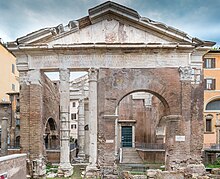Portico of Octavia
The Portico of Octavia ( Latin Porticus Octaviae ) is a quadriporticus in Rome .
The portico goes back to the 146 BC. Porticus Metelli built by Quintus Caecilius Metellus Macedonicus . This was left in situ and used again. According to ancient sources, Augustus had between 33 and 23 BC In the name of his sister Octavia he built the portico in a completely redesigned form. In the year construction began, the directly connected Porticus Philippi was completed. The Porticus Octaviae complex included a library and a curia . The portico was damaged in fires in 80 and 203, but was rebuilt and rededicated under Septimius Severus and his son Caracalla .
Dedicatory inscription
- [imp. caes. l. septimiu] S. SEVERVS. PIVS. PERTINAX. AVG. ARABIC. AD [iabenic. par] THIC. MAXIMVS / TRIB. POTEST. XI. IMP. XI. COS. III. P. P. ET / [imp. caes. m. aureliu] S. ANTONINVS. PIVS. FELIX. AVG. [trib.potest. VI] COS. PROCOS / INCENDIO. CORRVPTAM. REST [ituerunt]
The (analogous) translation is:
- "The Emperor Caesar Augustus Lucius Septimius Severus, Pius Pertinax Arabicus Adiabenicus Parthicus Maximus, who held tribunical power for the eleventh time, was imperator for the eleventh time, was consul for the eleventh time, and was father of the fatherland for the third time, and the emperor Caesar Augustus Marcus Aurelius Antoninus [Caracalla], Pius Felix, who held tribunical power for the sixth time, consul, proconsul, restored this colonnade after it was destroyed by fire "
The building contained numerous sculptural works of art, including a. the first publicly exhibited statue of a Roman woman, namely the Gracchen mother Cornelia , 34 equestrian statues made of bronze by Lysippus , which depicted Alexander the great with the generals who fell in the battle of Granicus , and a group of figures of Heliodorus .
The portico of Octavia is located between the Circus Flaminius and the Marcellus Theater . It is shown on the Forma Urbis . The portico enclosed a rectangular area; it was 119 m wide and about 132 m deep. Some columns in the south-east corner of the Theater des Marcellus have been excavated, and parts of the main entrance, which was on the narrow side of the portico facing the Tiber, have been preserved. This had a gable and consisted of a double hall with two rows of Corinthian columns. The preserved part of the main entrance, namely the gable and two columns in the outer row and three in the inner row, forms the entrance to the Church of Sant'Angelo in Pescheria . Since the excavations in the 1990s, further foundations have been uncovered in front of the church.
From around the 10th century, both the portico of Octavia and the arches of the Marcellus Theater were converted into shops and workshops in the course of the evacuation of the Jews from Trastevere ; the portico itself was a fish market until about the time of Giovanni Battista Piranesi in the mid-18th century. The street that passed it was therefore called “Via della Pescheria” ( Fish Market Street ) until it was renamed “Via del Portico d'Ottavia” in 1871.
Largo 16 ottobre 1943
In 1555 , Pope Paul IV had Rome's Jewish ghetto set up around the portico , from which 1007 people were deported in the “Judenaktion” on the night of October 15-16, 1943, of whom only seventeen returned. On October 16, 2002, Mayor Walter Veltroni named the place of this deportation of the Jews, the small square on Via del Portico d'Ottavia before the excavations in front of the Marcellus Theater and the Church of Sant'Angelo in Pescheria, the name Largo 16 ottobre 1943 . The plaque attached there mentions the Deportazione degli Ebrei di Roma ( deportation of the Jews of Rome ).
literature
- Jon Albers: Campus Martius. The urban development of the Field of Mars from the Republic to the Middle Imperial Period . Dr. Ludwig Reichert Verlag, Wiesbaden 2013, pp. 73, 75, 79–81, 106–109, 116, 145.
- Filippo Coarelli : Rome. An archaeological guide. Zabern, Mainz 2000, ISBN 3-8053-2685-8 , pp. 268-270.
- Samuel Ball Platner , Thomas Ashby : A Topographical Dictionary of Ancient Rome. Oxford University Press, London 1929, p. 427 ( online ).
- Lawrence Richardson Jr .: A New Topographical Dictionary of Ancient Rome . Johns Hopkins University Press, Baltimore 1992, p. 317 sv Porticus Octaviae.
Web links
Remarks
- ^ Suetonius , Augustus 29 ; Cassius Dio 49, 43.8 .
- ↑ Lawrence Richardson Jr. and Jon Albers interpret the ancient sources cautiously , because no mention is made of the financing and construction of the complex by Augustus in the res gestae . In addition: Lawrence Richardson Jr .: A New Topographical Dictionary of Ancient Rome . Johns Hopkins University Press, Baltimore 1992, p. 317 sv Porticus Octaviae; Jon Albers: Campus Martius. The urban development of the Field of Mars from the Republic to the Middle Imperial Period . Dr. Ludwig Reichert Verlag, Wiesbaden 2013, pp. 73, 75, 79–81, 106–109, 116, 145.
- ^ Building inscription of the restoration under Septimius Severus : CIL 6, 1034 .
- ↑ Pliny the Elder , Naturalis historia 34, 31 .
- ↑ The base of this bronze statue has been preserved and is located in the Conservator's Palace of the Museums on the Capitol.
- ^ Romolo A. Staccioli, Guida di Roma antica , Milano 1995, p. 307. ISBN 88-17-16585-9 .
- ↑ fragment 31 u .
- ^ Claudio Rendina, Donatella Paradisi: Le strade di Roma , volume terzo, p. 1068. ISBN 88-541-0210-5 .
- ↑ La Repubblica of October 16, 2002.
Coordinates: 41 ° 53 ′ 32.8 " N , 12 ° 28 ′ 42.7" E


